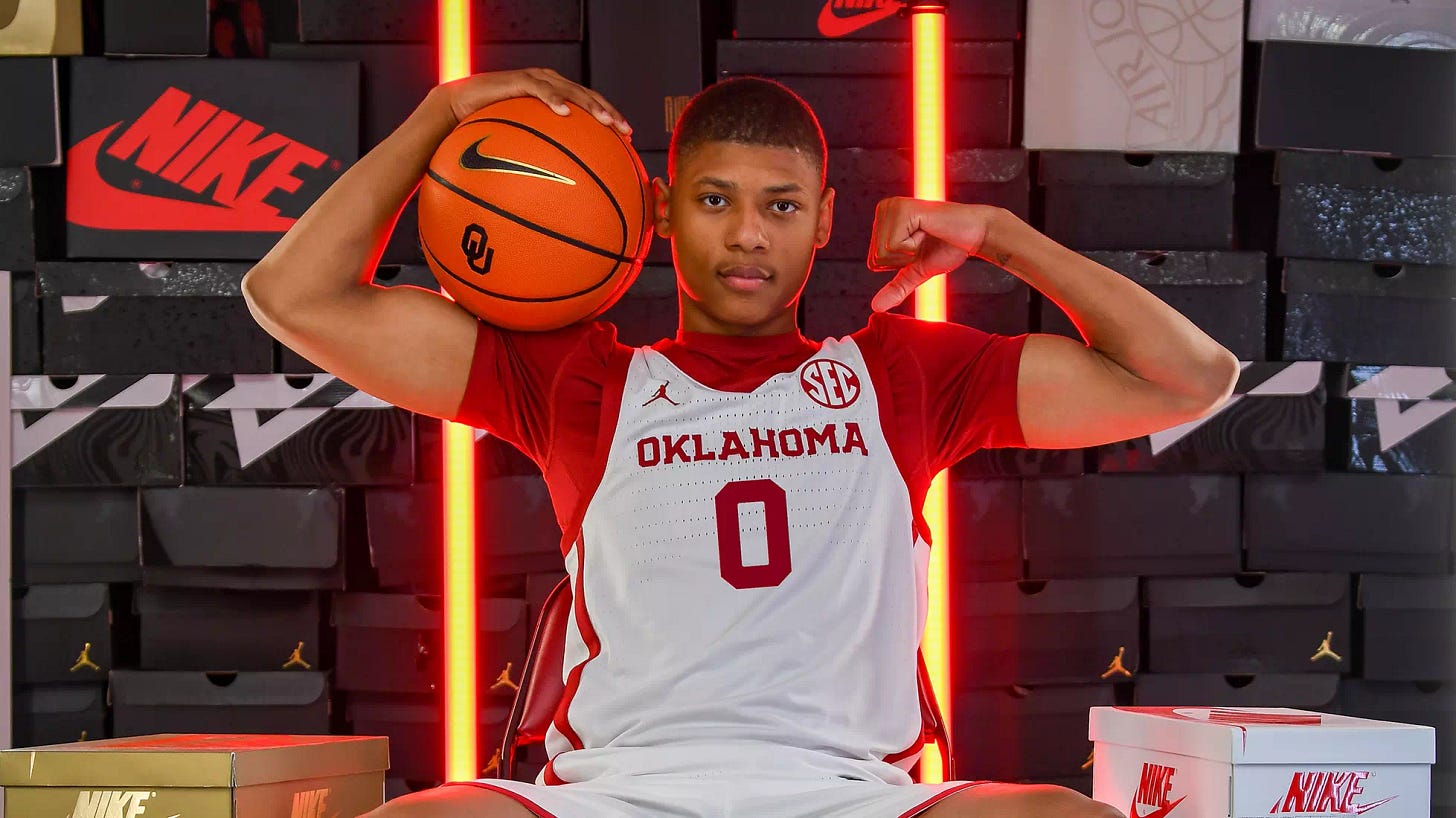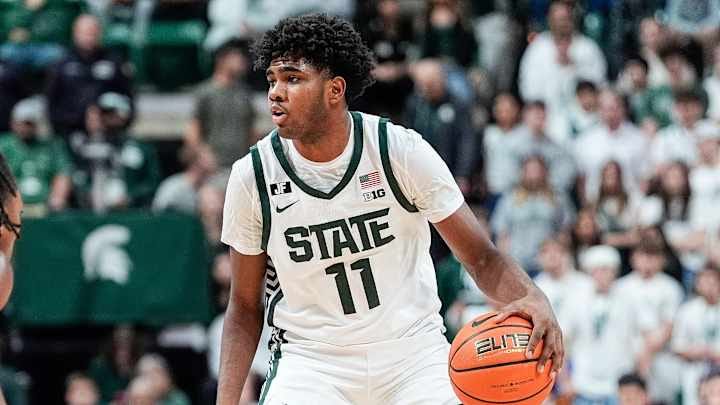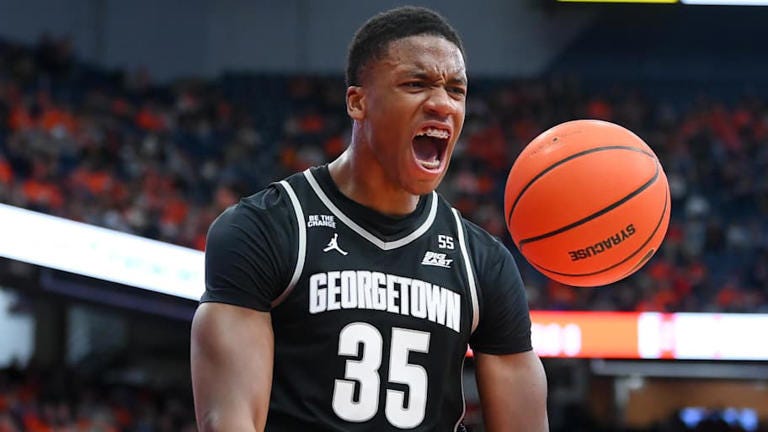2025 NBA Draft: Five Freshmen Sleepers
Looking at Oklahoma's Jeremiah Fears, Michigan State's Jase Richardson, Georgetown's Thomas Sorber, Arizona State's Joson Sanon, and Virginia's Jacob Cofie.
We’re about ten games into the college basketball season, which is a solid sample size to start picking and weeding out draft prospects. No need to rush into anything else. As with any cycle, there is always a crop of freshmen who unexpectedly stand out among the bunch.
Below are five first-year prospects who for whatever reason weren’t talked about much by most headed into this season, but have caught my attention so far:
Jeremiah Fears
Jeremiah Fears is an on-ball point guard who's flashed a lot of great signs while being productive (32.9 AST%) on really high usage (32.7 USG%) at a young age (he'll still be 18 y/o on draft night).
He needs to improve his efficiency as a jump shooter, but he can create his own shot from all three levels and his process is usually clean. Fears' pick-and-roll reads and versatility look advanced already, and his playmaking output is remarkable given his context as a reclassified freshman. Then, for all the advantages on offense, I also think he’ll hold up fine on defense despite being a good, not great athlete. Right now, I think of Fears as a top 15 pick with mobility to slide up into the mid-to-late lottery.
I really value Fears' passing and ballhandling. He can play fast in transition and slow down in the half-court. He creates threes, but also makes his bigs better. He can execute pocket passes and fizz passes over the top, with solid diversity on his deliveries (including jump passes). For now, I excuse Fears’ turnovers (23.7 TOV%) given his role and age, but they’ll have to go down in the long-term.
I like his pace as a ballhandler a lot. He changes speed and directions well, even though he isn't necessarily a blow-by threat from a standstill. Fears can chain moves together and break a defender down before getting into his drive or shot. The Oklahoma freshman also has potential in transition, especially once his body improves and he gets stronger. I think Fears gets rushed when he tries to go full-speed or play with a lot of contact right now. I’m keeping an eye on his finishing numbers in the half-court.
Also - this is not a problem, but I want Fears to keep improving his left hand as a passer and scorer. He's willing to drive left, but I think NBA teams would be able to target his weak hand right now.
Fears has a smooth and willing jumper, though I’d understand having some trepidation about his conversion (29.7 3P%, 30.3% on off-the-dribble jumpers). Again, though, Oklahoma is demanding a ton from him — so that context is a must — and, if one watches the tape, they’ll find that his process is largely encouraging. I think Fears will be able to attack bigs out of screens as a scorer. He can get to a stepback off the dribble or use his body to. create space. When combined with glimpses at the rim (64.2 FG%, 52.3 FTr, 86.2 FT%), I don’t think it’s crazy to believe Fears has three-level scoring potential to unlock.
Fears’ defensive effort is largely encouraging. Physicality can be an issue still (the case for most 18 y/os), as he cedes ground too easily and isn't the most adept at containing dribble penetration yet. But Fears’ positional size is okay (though not great), he is active off the ball, and he gets plenty of steals. He is attentive for a freshman, and I think he's shown some encouraging signs navigating screens, working to stay in front of pick-and-rolls, and staying engaged around 50/50 balls.
Fears was a four-star recruit who reclassified and committed to Oklahoma after initially choosing Illinois. The Sooners freshman previously won a gold medal with Team USA at the 2024 U-18 AmeriCup. He comes from a basketball family. His older brother Jeremy Fears Jr. is a sophmore at Michigan State. His dad Jeremy Sr. played college hoops at Ohio and Bradley, and also played professionally in Greece.
Fears was no. 18 on my last Big Board update and ⚠️ spoiler alert ⚠️ he’s already moved up on my next one: “Fears is a crafty and active pick-and-roll playmaker who already shows signs of having a pretty dynamic handle with changes of speed and direction. I also love how he’s flashed three-level self-creation.”
Jase Richardson
Jase Richardson has a case to be considered the best and most efficient in college basketball. He’s shooting 80% at the basket, 50% off the dribble, and 50% from three1 while posting a 10.6 BPM and 74.7 TS%. He’s also been a very reliable and safe playmaker with a 3.8 assist-to-turnover ratio and a 8.8 TOV%2.
I view Richardson as an off-ball guard prospect who can slot in next to a high-usage wing or big. He can add value with his decision-making off the catch, safe and connective passing, efficient shooting, and on/off-ball defensive discipline. However, the crux is that Richardson’s strengths come on incredibly low volume and limited versatility. That keeps me from picturing a higher ceiling and wanting him higher than the #20-30 range (probably more towards the latter half of that).
He has played less than 50% of Michigan State’s total minutes. He’s only taken 20 shots at the rim and from three. Right now, he’s averaging 1.9 assists per game. His usage is a very modest 15.7%.
I thought that the query below (for players who appeared in an NBA game) with some of those low usage indicators was interesting, since it had a number of NBA/NBA-adjacent guards but as freshmen (Davion Mitchell, Jason Preston, Reece Beekman, Jeff Dowtin, Monté Morris...). However, I’m not sure they have the same player profile as Richardson.
I have few doubts that Richardson can be counted on to make decisions off the catch. He’s dangerous attacking closeouts, as this Swish Theory piece by Roshan Potluri highlighted, and I like how he combines his speed and touch in these situations.
The vital thing, again, is whether Richardson can up his usage while maintaining (relatively speaking since I don’t expect those elite numbes to be sustainable) his outlier-good efficiency.
If he’s shooting in the high 30s from three, let’s say, but on higher volume, then the space and situations to carve out paths to the rim will exist so much more. Right now, he takes 2.0 threes per game and 5.5 threes per 100, which is low for a smallish off-ball guard.
As a playmaker, I like when Richardson forages into the paint using his quickness to create an advantage and makes an assertive strong-side read. I’m not sure Jase is very crafty as a facilitator or ballhandler, but he clearly understands how to make the correct decision and find the open man, usually out of spot-ups. He also isn’t someone who will hold onto the ball or pound it for a few seconds before keeping things moving, which I appreciate. Richardson needs few touches to be effective and efficient.
Defensively, Richardson has gotten stops on the ball and shown impressive off-ball instincts for a freshman. I wish his numbers were stronger (10 stocks in 10 games), but the tape is strong. The Michigan State freshman can keep his man in front using rangy, parallel strides, and he’s effective using his length to offer contests.
I think Jase has gotten an unlucky whistle at times, but he honestly can be handsy. Richardson also needs to keep getting stronger, although he's generally pretty disciplined at navigating screens (or at the very least, making an effort to). Thinking big picture, I also don't think he's very switchable. Richardson is long (his dad measured at 6'4.75'' in socks with a 6'11.5'' wingspan), but he’s not big or that athletic. In my eyes, he's limited to guarding 1s and 2s in the NBA.
Off the ball, I'm very impressed by Richardson's engagement and maturity. He is attentive to the action without ballwatching, and he's effective helping at the nail or in the paint. Jase then has the speed, length, and discipline to execute rangy closeouts while staying under control. He also uses his speed (and motor) to get back in transition.
Thomas Sorber
Thomas Sorber is another first-year prospect who’s a statistical darling. He was productive in high school and the EYBL circuit, but came into Georgetown with little fanfare as a four-star tweener big. Look at any draft community on the Internet and there’ll be people with Sorber in the first round or even lottery. I’m personally not that high on the Hoyas freshman as of now, but he definitely has my interest for the early second round. Sorber’s two-way production especially at the rim, steady decision-making and untapped athletic improvements are hard to overlook.
Starting with the numbers, which are very much in Sorber's favor, he is third in BPM among freshmen (10.8 behind only Derik Queen and Dylan Harper) with strong rebounding numbers (10.5 OREB%, 23.6 DREB%), low turnovers (1.8 assist-to-turnover ratio), and high defensive playmaking (1.7 blocks per game, 6.9 BLK%, 2.9 STL%).
Sorber has also been dominant in the paint (80.4 FG% on 45/56 shooting) and has flashed just about enough shooting upside (76.5 FT% on 39/51 attempts). He’s 6-foot-10 with a 255-pound frame that has already markedly improved but still has room to get better under NBA supervision.
All of that evidently sounds great, but here’s where I feel uneasy about the Georgetown freshman. Sorber’s competition so far leaves much to be desired. Sorber has beat up on teams like Fairfield, Albany and UMBC, for instance, which place out of Bart Torvik’s top 200. However, he struggled more against top-120, competitive teams in Notre Dame, West Virginia or Syracuse. Sorber was still relatively productive (12, 13, 16 points) but his efficiency clearly suffered (33.3 FG%, 44.4 FG%, 43.8 FG%).
Most of all, I’m not sure what type of role his skillset can translate to in the NBA. Right now, Sorber spends most of the time posting up. He scores 1.132 points per possession, a very good figure. The Hoyas prospect can make a quick move and finish through his defender. Georgetown seeks Sorber out, running cross-screens down low for dunker-to-dunker cuts and such. However, I just don't think those types of looks will exist for him as often in the NBA — nor will they be as efficient.
I have concerns against longer, bigger, and more athletic bigs in the league, particularly if Sorber is going to be a 5 — which I think he has to be right now. He can have a tough time against length, and he has a tendency to fade away that I’m not convinced by.
I also think that, for all intents and purposes, he can’t shoot yet. I prefer Sorber as a roller, but his numbers there aren't that good right now. That said, his overall conversion at the rim (80.4 FG%, 1.61 PPS) and touch from the free throw line (76.5 FT% on 39/51 foul shots) can make one optimistic. We haven't seen him in transition enough for my liking and to project his NBA outlook there (4.4% of the time, per Synergy), though his playstyle seems like it’s benefited by a slower pace.
On defense, Sorber is putting together an impressive freshman season. He has 31 stocks in 10 games (3.1 stocks per game), plus a 6.9 BLK%, so he's clearly creating events on this end. I’m waiting for Sorber to face a stretch of higher-level competition before making more of a judgment on this side of the ball. Most recently against Syracuse, I thought he was solid guarding the pick-and-roll, but had mixed moments in space fouling on a three-pointer and a face-up. Sorber also struggled with the size of Eddie Lampkin Jr. (265-pound graduate student) and although he wouldn’t really face that type of big in the NBA, I do want to keep seeing how the Hoyas big does against centers who are even stronger and more physical than him.
Georgetown’s schedule is about to get hot with games against Creighton, Seton Hall, Xavier, Marquette, UConn, and St. John’s on the horizon, so let’s see how Sorber holds up.
Joson Sanon
Joson Sanon previously said that he’d be a one-and-done, and it’s tough to feel like that’s a bad decision the way his freshman season at Arizona State is going. Through his first 10 games, Sanon is averaging 14.8 points, 3.5 rebounds, and 1.3 assists on 52% from three.
Sanon is a scorching movement shooter with decent but not great positional size at around 6-foot-5 in shoes with a 6-foot-6 wingspan. It's the way he shoots the ball that will get him on draft boards, as Sanon is drilling 52% of his threes, 58.1% of his catch-and-shoots, and 51.2% of his off-the-dribble jumpers. The Sun Devils freshman takes 5.0 threes per game and 9.8 threes per 100 possessions. 47.6% of his shots are threes, as of Dec. 18.
Sanon is definitely producing, but his underlying numbers and lack of versatility on tape are cause for concern. I can’t justify placing a prospect who might be a great shooter, but who can’t put pressure on the rim, facilitate, rebound or defend higher than the mid-to-late second round. The Sun Devils prospect’s shooting looks really good, but he’ll struggle to stick in the NBA if he doesn’t make leaps in basically every other ancillary skill.
The Arizona State freshman has only made 41.7% of his shots at the rim, a figure that dwindles to 36.8% (7/19) in the half-court. Sanon also doesn’t get to the free throw line (24.8 FTr) and he’s shooting under 70% from there, even though his shooting indicators are good/very good everywhere else. His efficiency (63.1 TS%) being buoyed by far twos and tough threes isn’t ideal, though maybe he’s just that good of a shooter (I remember scouting Sanon at the 2024 Adidas Eurocamp and being impressed by his shooting even then, though I thought he looked better driving).
Plus, Sanon is limited as a decision maker (9.8 AST%, 11.4 TOV%) and he doesn't really contribute as a rebounder or defender (0.8 STL% and BLK%). I’d also like to see Joson play better against good competition. He scored 3 points against Gonzaga and 5 points against Florida.
Jacob Cofie
Jacob Cofie is one of the most slept on prospects in college basketball, and he’s a future NBA name to watch even if the 2025 Draft might come too early. The Virginia freshman is on track for a big breakout at some point, I think in 2026, and he’s already been impressive this season.
My pitch on Cofie is that he’s an athletic 6-foot-10 forward who finishes plays by blocking shots (6.4 BLK%) and rebounding (10.3 OREB%, 23.7 DREB%), and who flashes plausible upside as a vertical spacer in terms of dunking/finishing and three-point shooting. Cofie is only making 28% of his threes, but he takes 7.4 triples per 100 and he’s 100% from the free throw line, albeit on a tiny 12/12 sample size. Big picture, I’m looking at Cofie in a mold similar to Taylor Hendricks. He plays the 4 a lot right now, but I think he’ll end up playing the 5, too.
As of Dec. 18, the Virginia freshman and VJ Edgecombe are the only NCAA players who meet the following criteria: OREB % ≥ 10; Ast/TO Ratio ≥ 1; BLK % ≥ 2; STL % ≥ 2; 3PA/100 Poss ≥ 7; BPM +/- ≥ 5; Dunks made ≥ 5. That shows production and athleticism (particularly around the basket), rebounding, ball security, defensive playmaking, and shooting upside.
However, Cofie needs more seasoning and experience. You can tell he’s a young freshman, as he just looks very raw at times with his decision-making and overall inconsistency. His three-pointer can fluctuate from clean makes to bad misses, for instance. Defensively, he might suddenly disengage off-ball or randomly lose focus on a rebound. I’m not sure most NBA teams in the 2025 draft would have the time to work through those growing pains with him, which is why I again mention 2026. Overall, though, Cofie has come a long way defensively when looking at his play over high school until now.
The Virginia freshman can be impactful rotating and altering shots at the basket, although his hand/arm placement needs more discipline still. Cofie’s length and mobility give him the ground coverage tools NBA teams covet and, even though his process isn't seamless, he's getting blocks while largely staying out of foul trouble. Going forward, I want to see Cofie clean up his avoidable mistakes, although I’m encouraged by the mere fact that he’s at Virginia. He can overshoot a closeout or get his body angle wrong defending screens and box-outs too often.
Another thing I’ll be looking for from Cofie, although on offense, is improved assertiveness at the basket. This is particularly important if he is to eventually transition into a center. The UVA freshman is finishing 68.8% of his shots at the rim, a good number, but his volume is nearly halved when looking at only the half-court. Then, Cofie barely gets to the free throw line, having attempted (and made) just 12 foul shots in 10 games this season. I also feel like he can be predictable wanting to go 1-2 dribbles right, to then try spinning left.
Numbers via Synergy — this will be the case going forward for the rest of the piece…
Numbers per Bart Torvik — this will be the case going forward for the rest of the piece…










